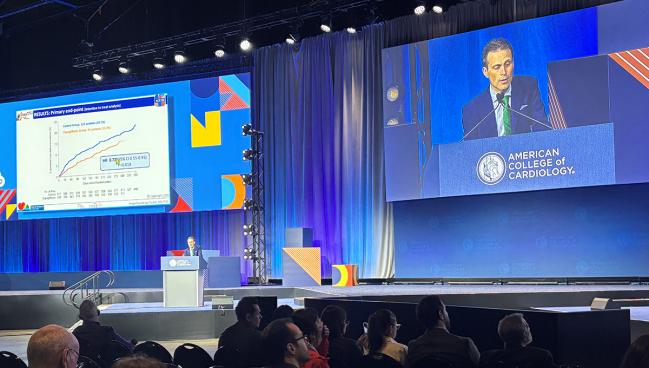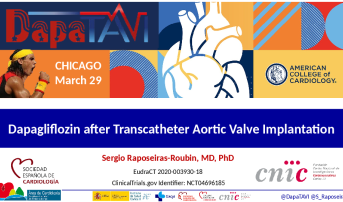Dapagliflozin Works Well for High-Risk TAVI Patients With HF: DapaTAVI
Patients with aortic stenosis were excluded from earlier trials of the SGLT2 inhibitor, but new data confirm they too can benefit.

CHICAGO, IL—High-risk older patients with a history of heart failure (HF) who are undergoing transcatheter aortic valve implantation have better outcomes when taking dapagliflozin, results from the DapaTAVI randomized trial show.
The results were presented yesterday during a late-breaking trial session at the American College of Cardiology (ACC) 2025 Scientific Session and published in the New England Journal of Medicine.
Treatment of aortic stenosis has been transformed by TAVI over the past 20 years, though even with the intervention, “patients still face high rates of heart failure, especially during the first year [postprocedure],” said lead investigator Sergio Raposeiras-Roubín, MD, PhD (Hospital Álvaro Cunqueiro, Estrada de Clara, Pontevedra, Spain).
Dapagliflozin (Farxiga; AstraZeneca), an SGLT2 inhibitor, is recommended in heart failure irrespective of ejection fraction but thus far had not been specifically tested in TAVI, since patients with valvular heart disease have largely been excluded from randomized trials of the drug, he added. TAVI patients tend to be older, as well, and that population also tends to be excluded from trials.
Wayne Batchelor, MD (Inova Health System, Fairfax, VA), who commented on the new study in an ACC press conference, drew attention to its clinical relevance.
“As an interventional cardiologist, I love to see the intersection between medical therapy and the interventions we do in the cath lab, and how they complement each other, potentially. I think this is a good example [of that],” Batchelor told journalists. SGLT2 inhibitors have “gained of lot of steam” in recent years for patients both with and without diabetes, especially when it comes to the endpoint of heart failure, he noted. “It makes a lot of sense to study this particular cohort.”
At the same time, “TAVR has become almost commoditized in the United States,” with more than 80 centers now doing 100,000 cases in the course of a year, said Batchelor. “It’s less than 1% mortality at 1 month—but at 1 year, it’s 10%. . . . So, there’s opportunity here to reduce events in this patient population.”
The DapaTAVI results make sense, Batchelor told TCTMD. “Basically, if you’ve had a history of heart failure and you’re already on decent guideline-directed medical therapy and you happen to have aortic stenosis, you’ll benefit as much as a patient who we would actually treat normally anyway with [dapagliflozin]. To me this is almost just confirming that our normal treatment pattern is valid in patients with aortic stenosis.”
Deepak Bhatt, MD (Mount Sinai Health System, New York, NY), discussant for DapaTAVI in the ACC session, said that dapagliflozin until now has not typically been on the minds of cardiologists treating TAVI patients.
“I know for me [the trial] will be practice changing when I go back next week to New York. I think I’m pretty good about my heart failure patients in making sure that those without contraindications are discharged on an SGLT2 inhibitor. But I must say, in my TAVI or TAVR patients, that’s not [been] part of the checklist,” he commented.
DapaTAVI
The investigator-initiated DapaTAVI trial randomized 1,257 patients with aortic stenosis (mean age 82.4 years; 49.4% women) at 39 centers across Spain to start receiving either 10 mg dapagliflozin once daily or standard care. All were slated for TAVI, had a history of HF, and had at least one risk factor: renal insufficiency (eGFR 25-75 mL/min/1.73 m2), diabetes, or left systolic dysfunction (LVEF ≤ 40%).
Among the 1,222 patients in the main analysis, the primary endpoint—death from any cause or worsening HF (either hospitalization or urgent visit) at 1 year occurred less frequently in those assigned to dapagliflozin versus standard care (15.0% vs 20.1%; HR 0.72; 95% CI 0.55-0.95). The difference was driven by worsening HF (9.4% 14.4%; subhazard ratio 0.63; 95% CI 0.45-0.88), with no difference in all-cause death (7.8% vs 8.9%; hazard ratio 0.87; 95% CI 0.59-1.28).
“It’s interesting to see that the curves separated early and remained separate,” said Batchelor. “Probably there’s a treatment effect at 30 days, and certainly by 60 days it looked like the degree of separation between the curves was very similar to at 1 year. So this is a very rapidly impactful therapy that truly works.”
Subgroup analyses hinted at better results with dapagliflozin in those age 80 and older, men, and those on RAS inhibitors or diuretics as well as patients with diabetes, hypertension, atrial fibrillation, LVEF > 40%, and eGFR < 60 mL/min/173 m2.
However, dapagliflozin use was not without complications: patients in the treatment group were more likely to develop genital infection (1.8% vs 0.5%; P = 0.03) and hypotension (6.6% vs 3.6%; P = 0.01) than those randomized to standard care.
For Batchelor, this “safety signal is not inconsequential,” given that one in five patients discontinued dapagliflozin by 1 year. “It’s not a panacea in terms of its ability to be tolerated,” he cautioned.
Ori Ben-Yehuda, MD (University of California, San Diego, La Jolla), in an NEJM editorial, points out that the DapaTAVI patients, by virtue of having heart failure, ostensibly would be candidates for dapagliflozin. Still, the idea that aortic stenosis is a mechanical problem that can be solved by intervention, coupled with the older population that’s affected, has led to underuse of the SGLT2 inhibitor in this setting.
“The benefit of dapagliflozin in the TAVI population highlights the fact that despite the relief of the outflow obstruction, these patients do not have a normal heart. Long-standing aortic stenosis, even in the absence of symptoms, leads not only to left ventricular hypertrophy but also to fibrosis and myocyte degeneration,” he writes, adding that patients with aortic stenosis tend to have cardiometabolic disease and elevated Lp(a) levels.
DapaTAVI’s results “open the door” to additional research on medical therapy, Ben-Yehuda concludes.
Caitlin E. Cox is News Editor of TCTMD and Associate Director, Editorial Content at the Cardiovascular Research Foundation. She produces the…
Read Full BioSources
Raposeiras‑Roubin S, Santos A, Rossello X, et al. Dapagliflozin in patients undergoing transcatheter aortic-valve implantation. N Engl J Med. 2025;Epub ahead of print.
Ben-Yehuda O. Aortic stenosis — when valve intervention is not enough. N Engl J Med. 2025;Epub ahead of print.
Disclosures
- Raposeiras‑Roubin and Ben-Yehuda report no relevant conflicts of interest.






Comments